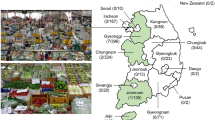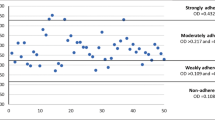Abstract
Escherichia coli is generally considered as an indicator of antimicrobial resistance due to its genetic flexibility and adaptability. In the present study, antimicrobial resistance patterns, biofilm formation ability, and genotypes were assessed in E. coli isolates from fresh vegetable products in Korea. Among 120 isolates, 22 isolates (18.3 %) were resistant to one or more antimicrobials and 11 isolates were concurrently multidrug resistant against up to six antimicrobial agents. The highest resistance rate was detected on ampicillin (14.2 %), followed by piperacillin (11.7 %) and cefalotin (10.0 %). Rep-Polymerase chain reaction (PCR) revealed that five out of the 26 isolates were assigned to one cluster with a similarity >95 %, and strains carrying the same antimicrobial resistance profile had discrete rep-PCR patterns. A biofilm formation assay demonstrated that significantly larger amounts of biofilm were formed by an isolate, which showed no antimicrobial resistance. However, 60 % of the five intermediated biofilm-forming E. coli exhibited multidrug resistance against three or four antimicrobial agents. These results suggest that fresh vegetable products contaminated with E. coli are sources of antimicrobial resistance and other diverse virulence determinants. Therefore, the information provided in this study can be useful for improving food safety and public health.

Similar content being viewed by others

References
Arnold JW, Silvers S (2000) Comparison of poultry processing equipment surfaces for susceptibility to bacterial attachment and biofilm formation. Poult Sci 79:1215–1221
Barlow M (2009) What antimicrobial resistance has taught us about horizontal gene transfer. Methods Mol Biol 532:397–411
Baur B, Hanselmann K, Schlimme W, Jenni B (1996) Genetic transformation in freshwater: Escherichia coli is able to develop natural competence. Appl Environ Microbiol 62:3673–3678
Beuchat LR (2002) Ecological factors influencing survival and growth of human pathogens on raw fruits and vegetables. Microbes Infect 4(4):413–423
Bridier A, Briandet R, Thomas V, Dubois-Brissonnet F (2011) Resistance of bacterial biofilms to disinfectants: a review. Biofouling 27(9):1017–1032
Carattoli A (2013) Plasmids and the spread of resistance. Int J Med Microbiol 303(6–7):298–304
Cerf O, Carpentier B, Sanders P (2010) Tests for determining in-use concentrations of antibiotics and disinfectants are based on entirely different concepts: “resistance” has different meanings. Int J Food Microbiol 136(3):247–254
Clinical and Laboratory Standards Institute (CLSI) (2010) Performance standards for antimicrobial susceptibility testing; Twentieth informational supplement. CLSI document M100-S20. Clinical and Laboratory Standards Institute, USA, Wayne
Cohen ML (2000) Changing patterns of infectious disease. Nature 406:762–767
Delaquis P, Bach S, Dinu LD (2007) Behavior of Escherichia coli O157:H7 in leafy vegetables. J Food Prot 70(8):1966–1974
Erickson MC, Webb CC, Diaz-Perez JC, Phatak SC, Silvoy JJ, Davey L, Payton AS, Liao J, Ma L, Doyle MP (2010) Surface and internalized Escherichia coli O157:H7 on field-grown spinach and lettuce treated with spray-contaminated irrigation water. J Food Prot 73:1023–1029
European Food Safety Authority (EFSA) (2011) Urgent advice on the public health risk of Shigatoxin producing Escherichia coli in fresh vegetables. EFSA J 9:2274
Hall-Stoodley L, Stoodley P (2005) Biofilm formation and dispersal and the transmission of human pathogens. Trends Microbiol 13:7–10
Hall-Stoodley L, Costerton JW, Stoodley P (2004) Bacterial biofilms: from the natural environment to infectious diseases. Nat Rev Microbiol 2:95–108
Harapas D, Premier R, Tomkins B, Franz P, Ajlouni S (2010) Persistence of Escherichia coli on injured vegetable plants. Int J Food Microbiol 138(3):232–237
Holvoet K, Sampers I, Callens B, Dewulf J, Uyttendaele M (2013) Moderate prevalence of antimicrobial resistance in Escherichia coli isolates from lettuce, irrigation water, and soil. Appl Environ Microbiol 79(21):6677–6683
Khandaghi J, Razavilar V, Barzgari A (2010) Isolation of Escherichia coli O157:H7 in manure fertilizer farms and raw vegetables grown on it, in Tabriz city in Iran. Afr J Microbiol Res 4(9):891–895
Kim SM, Park JH, Lee HS, Kim WB, Ryu JM, Han HJ, Choi SH (2013) LuxR homologue SmcR is essential for Vibrio vulnificus pathogenesis and biofilm detachment, and its expression is induced by host cells. Infect Immun 81(10):3721–3730
Kim HJ, Koo M, Jeong A, Baek S, Cho J, Lee S, Hwang I (2014) Occurrence of pathogenic Escherichia coli in commercially available fresh vegetable products in Korea. J Korean Soc Appl Biol Chem 57(3):367–370
Lindow SE, Brandl MT (2003) Microbiology of the phyllosphere. Appl Environ Microbiol 69:1875–1883
Morris CE, Monier JM, Jacques MA (1998) A technique to quantify the population size and composition of the biofilm component in communities of bacteria in the phyllosphere. Appl Environ Microbiol 64:4789–4795
Rayner J, Veeh R, Flood J (2004) Prevalence of microbial biofilms on selected fresh produce and household surfaces. Int J Food Microbiol 95(1):29–39
Ryu SH, Lee JH, Park SH, Song MO, Park SH, Jung HW, Park GY, Choi SM, Kim MS, Chae YZ, Park SG, Lee YK (2012a) Antimicrobial resistance profiles among Escherichia coli strains isolated from commercial and cooked foods. Int J Food Microbiol 159(3):263–266
Ryu SH, Park SG, Choi SM, Hwang YO, Ham HJ, Kim SU, Lee YK, Kim MS, Park GY, Kim KS, Chae YZ (2012b) Antimicrobial resistance and resistance genes in Escherichia coli strains isolated from commercial fish and seafood. Int J Food Microbiol 152(1–2):14–18
Scallan E, Griffin PM, Angulo FJ, Tauxe RV, Hoekstra RM (2011) Foodborne illness acquired in the United States—unspecified agents. Emerg Infect Dis 17(1):16–22
Schroeder CM, Meng J, Zhao S, DebRoy C, Torcolini J, Zhao C, McDermott PF, Wagner DD, Walker RD, White DG (2002) Antimicrobial resistance of Escherichia coli O26, O103, O111, O128, and O145 from animals and humans. Emerg Infect Dis 8(12):1409–1414
Skočková A, Karpíšková R, Koláčková I, Cupáková Š (2013) Characteristics of Escherichia coli from raw vegetables at a retail market in the Czech Republic. Int J Food Microbiol 167(2):196–201
Soledad Ramírez M, Merkier AK, Almuzara M, Vay C, Centrón D (2010) Reservoir of antimicrobial resistance determinants associated with horizontal gene transfer in clinical isolates of the genus Shewanella. Antimicrob Agents Chemother 54(10):4516–4517
Szmolka A, Nagy B (2013) Multidrug resistant commensal Escherichia coli in animals and its impact for public health. Front Microbiol 4:258
Tyerman JG, Ponciano JM, Joyce P, Forney LJ, Harmon LJ (2013) The evolution of antibiotic susceptibility and resistance during the formation of Escherichia coli biofilms in the absence of antibiotics. BMC Evol Biol 13:22
Tzschoppe M, Martin A, Beutin L (2011) A rapid procedure for the detection and isolation of enterohemorrhagic Escherichia coli (EHEC) serogroup O26, O103, O111, O118, O121, O145 and O157 strains and the aggregative EHEC O104:H4 strain from ready-to-eat vegetables. Int J Food Microbiol 152:19–30
Wright GD (2007) The antimicrobial resistome: the nexus of chemical and genetic diversity. Nat Rev Microbiol 5:175–186
Yong DG, Shin HB, Kim YK, Cho JH, Lee WG, Ha GY, Choi TY, Jeong SH, Lee KW, Chong YS, the KONSAR group (2014) Increase in the prevalence of Carbapenem-resistant Acinetobacter isolates and ampicillin-resistant non-typhoidal salmonella species in Korea: a KONSAR study conducted in 2011. Infect Chemother 46(2):84–93
Acknowledgments
This research was supported by a grant from Korea Food Research Institute and by Basic Science Research Program through the National Research Foundation of Korea (NRF) funded by the Ministry of Education, Science and Technology (2012R1A1A2008740).
Author information
Authors and Affiliations
Corresponding author
Rights and permissions
About this article
Cite this article
Kim, S.M., Oh, T. & Kim, H.J. Antimicrobial resistance, molecular, and phenotypic diversity of Escherichia coli isolates from fresh vegetable products in Korea. J Korean Soc Appl Biol Chem 58, 745–750 (2015). https://doi.org/10.1007/s13765-015-0104-0
Received:
Accepted:
Published:
Issue Date:
DOI: https://doi.org/10.1007/s13765-015-0104-0



